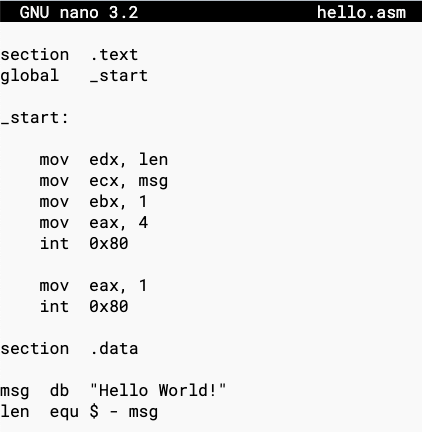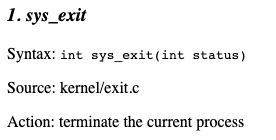
sudo apt update
sudo apt install build-essential gcc-multilib gdb nasm netcat-openbsd -y
Execute this command to create a "hello.asm" file:
nano hello.asm
section .text
global _start
_start:
mov edx, len
mov ecx, msg
mov ebx, 1
mov eax, 4
int 0x80
mov eax, 1
int 0x80
section .data
msg db "Hello World!"
len equ $ - msg

Execute these commands to compile, link, and run the program:
nasm -f elf32 hello.asm
ld -m elf_i386 -o hello hello.o
./hello

The eax register defines which system call you are making, and the other registers are used for parameters, as shown below.

Here's the prototype of system call 4, from this page:

Here's that code with explanatory comments:
mov edx, len ; length of string to print
mov ecx, msg ; address of string to print
mov ebx, 1 ; file descriptor: 1 = stdout
mov eax, 4 ; syscall #4 is sys_write
int 0x80 ; execute the syscall

Here's that code with explanatory comments:
mov eax, 1 ; syscall #1 is sys_exit
int 0x80 ; execute the syscall
section .data
msg db "Hello World!" ; db = Define Byte, ASCII encoded
len equ $ - msg ; defines a constant
section .data
msg db "Hello World!"
len equ $ - msg

Theory
If you just want to do the hands-on projects, skip this section.Background
Refer to this tutorial:Assembly Programming TutorialAnswer the questions below.
ASM 100.1: Section (2 pts)
There are three sections to an assembly program, including the text and data sections used above. What is the third section?
ASM 100.2: Size (2 pts)
How many bits are in the AX register?
ASM 100.3: Syscall (2 pts)
What's the name of system call #6?
ASM 100.4: TBYTE (2 pts)
How many bytes are in a TBYTE?
ASM 100.5: MUL (2 pts)
When two DWORD values are multiplied, what register contains the higher-order bits?
ASM 100.6: XOR (2 pts extra)
What is the value of eax after processing these commands?mov eax, 19 xor eax, 61
ASM 100.7: NOT (2 pts extra)
What is the value of al after processing these commands?al is the lower eight bits of eax.
mov al, 19 not al
ASM 100.8: LOOP (2 pts extra)
Where is the loop count stored when using the LOOP instruction?
ASM 100.9: CMPSD (2 pts extra)
What register points to the destination operand when using the CMPSD instruction?
ASM 100.10: REP (2 pts extra)
What register controls the number of repitions when using the REP prefix?
ASM 100.11: '6' (2 pts extra)
What is the decimal value in EBX after this instruction is executed?mov ebx, '6'
ASM 100.12: 01000001B (2 pts extra)
What is the decimal value in EBX after this instruction is executed?mov ebx, 01000001B
ASM 100.13: sys_write (5 pts extra)
What is the decimal value in EAX after this code is executed?
ASM 100.14: pop (2 pts extra)
What is the decimal value in EAX after this code is executed?
ASM 100.15: (3 pts extra)
What is the decimal value in EDX after the instruction outlined in green below is executed?
ASM 100.16: HEAD (5 pts)
Write a program named head that constructs a HEAD request, as shown below.Then execute this command to get the flag, which is covered by a green rectangle in the image below:
Hint: Each line must end with a carriage return and a line feed, in that order--that is, 13,10.
Also, there is an extra blank line at the end.
ASM 100.17: GET (5 pts)
Open this Web page:http://target1.bowneconsulting.com/php/asm1.php
Log in as shown below.
You don't get the flag.
Write a program named get that constructs the correct a GET request, as shown below.
Then execute this command to get the flag, which is covered by a green rectangle in the image below:
Hint: Each line must end with a carriage return and a line feed, in that order. Also, there is an extra blank line at the end.
ASM 100.18: BRUTE (10 pts extra)
Open this Web page:http://target1.bowneconsulting.com/php/asm2.php
Write a program that logs in with these parameters, as shown below:
Hint: use a loop.
- HTTP method is GET, as in the previous challenge
- Username: admin
- Password: password followed by a single digit
- User-Agent: ASMCODE
The flag is covered by a green rectangle in the image below:
ASM 100.19: BRUTE (15 pts extra)
Open this Web page:http://target1.bowneconsulting.com/php/asm3.php
Write a program that logs in with these parameters, as shown below:
A successful login will reveal the flag.
- HTTP method is GET, as in the previous challenge
- Username: admin followed by a single digit
- Password: password followed by a single digit
- User-Agent: ASMCODE